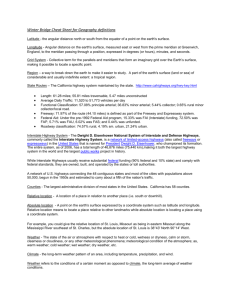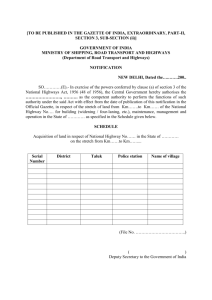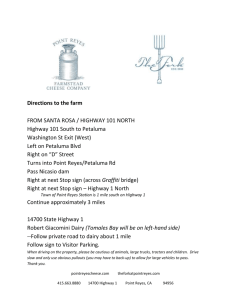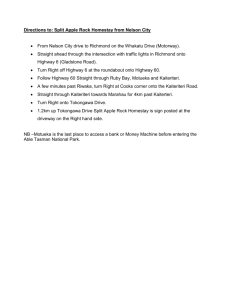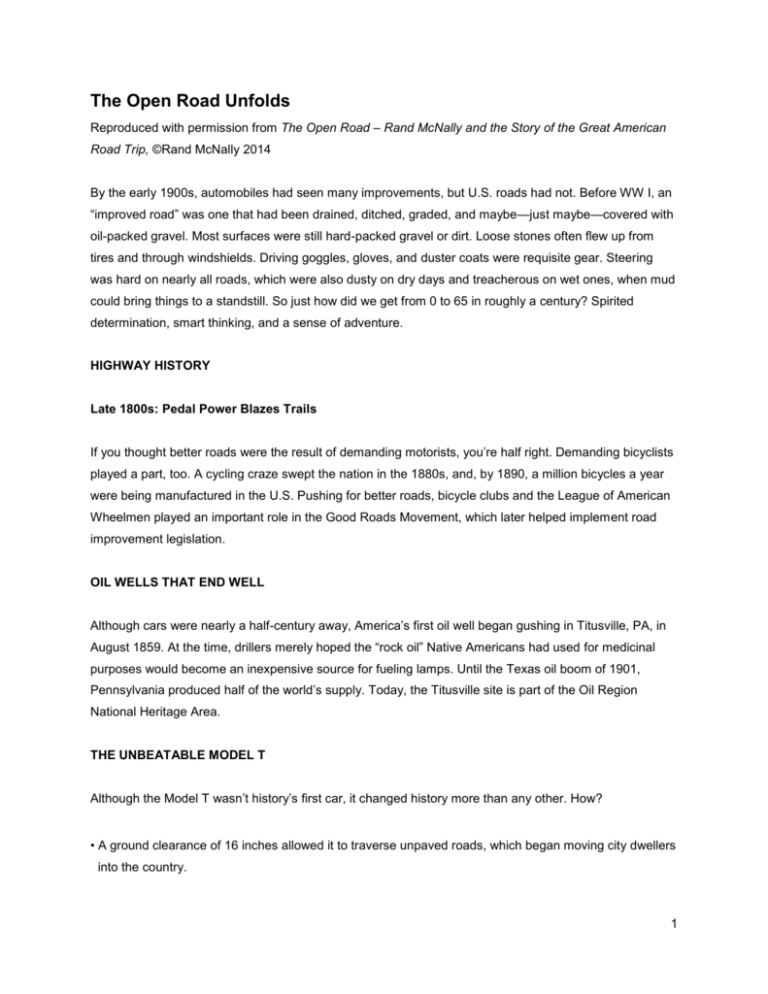
The Open Road Unfolds
Reproduced with permission from The Open Road – Rand McNally and the Story of the Great American
Road Trip, ©Rand McNally 2014
By the early 1900s, automobiles had seen many improvements, but U.S. roads had not. Before WW I, an
“improved road” was one that had been drained, ditched, graded, and maybe—just maybe—covered with
oil-packed gravel. Most surfaces were still hard-packed gravel or dirt. Loose stones often flew up from
tires and through windshields. Driving goggles, gloves, and duster coats were requisite gear. Steering
was hard on nearly all roads, which were also dusty on dry days and treacherous on wet ones, when mud
could bring things to a standstill. So just how did we get from 0 to 65 in roughly a century? Spirited
determination, smart thinking, and a sense of adventure.
HIGHWAY HISTORY
Late 1800s: Pedal Power Blazes Trails
If you thought better roads were the result of demanding motorists, you’re half right. Demanding bicyclists
played a part, too. A cycling craze swept the nation in the 1880s, and, by 1890, a million bicycles a year
were being manufactured in the U.S. Pushing for better roads, bicycle clubs and the League of American
Wheelmen played an important role in the Good Roads Movement, which later helped implement road
improvement legislation.
OIL WELLS THAT END WELL
Although cars were nearly a half-century away, America’s first oil well began gushing in Titusville, PA, in
August 1859. At the time, drillers merely hoped the “rock oil” Native Americans had used for medicinal
purposes would become an inexpensive source for fueling lamps. Until the Texas oil boom of 1901,
Pennsylvania produced half of the world’s supply. Today, the Titusville site is part of the Oil Region
National Heritage Area.
THE UNBEATABLE MODEL T
Although the Model T wasn’t history’s first car, it changed history more than any other. How?
• A ground clearance of 16 inches allowed it to traverse unpaved roads, which began moving city dwellers
into the country.
1
• Henry Ford’s first car, the 1896 Quadricycle, used Harvey Firestone’s tires. Ford was so pleased with
his pal’s product that, in 1906, one of the first major orders for his growing company was 2,000 sets of
Firestone tires. The partnership lasted for almost 100 years.
• Firestone and Ford were both friends with Thomas Edison. All three men worked on finding an
alternative source for rubber in the lab at Edison’s Fort Myers, FL, summer home (which was next door
to Ford’s summer home).
• As Model T production increased, prices dropped from $850 in 1909 to $260 in 1925.
• In 1914 Henry Ford simultaneously reduced his workers’ hours while more than doubling their pay to $5
per day. (He wanted the people who built his Model Ts to be able to afford them.)
• Entering the 1920s, Model Ts accounted for nearly 57% of worldwide auto production. More than 15
million were sold between 1909 and 1927.
HIGHWAY HISTORY
1900s: Grassroots Pave the Way
In the early days, it was often such grassroots groups as auto trail clubs and highway associations that
established and maintained many routes, including the famous Lincoln Highway. They also tried, with
varying degrees of success, to set standards for construction materials, road widths, curves, and grades.
These groups also had definite opinions on billboards (no) and comfort stations (yes). As America’s car
culture developed, though, it was clear that better and more uniform roads were needed.
In 1916 President Woodrow Wilson signed the Federal-Aid Road Act, the first to earmark federal aid for
highway construction and maintenance. It was meant to assist the rural population with postal roads,
urban motorists with paved highways, and everyone with increased interstate commerce. It also opened
the door for improved legislation, specifically the Federal-Aid Highway Act of 1921.
PRE-HISTORIC VEHICLES
Henry Ford’s Model T wasn’t the first car. It wasn’t even the second or third or twentieth car. For more
than a century before Ford, tinkerers and inventors—mostly in Europe—experimented with dozens of
different approaches. Here are five attempts that moved things forward between 1770 and 1897.
• Cugnot Steam Trolley, 1770 (Nicolas-Joseph Cugnot, France)
2
• Puffing Devil, 1801 (Richard Trevithick, Great Britain)
• La Mancelle, 1878 (Amédée Bollée, France)
• Benz Patent Motorwagen, 1885 (Karl Benz, Germany)
• Präsident, 1897 (Leopold Sviták and Hans Ledwinka, today’s Czech Republic)
OPEN ROAD FIRSTS
• To win a $50 bet, in 1903 Dr. Horatio Nelson Jackson and Sewall Crocker drove a Winton touring car
from San Francisco to New York City. With few real roads to follow, it took them 63 days.
• Traveling with Jackson and Crocker was a pit bull named Bud, the first dog to make a transcontinental
road trip. Like his human companions, Bud often wore goggles.
• In 1909, 22-year-old Alice Huyler Ramsey was the first woman to make a cross-country auto trip. Her
3,800-mile journey from Manhattan to San Francisco in a Maxwell 30 took 59 days.
• In the early 1900s, Erwin “Cannonball” Baker made 143 transcontinental motorcycle trips. After his
record-breaking 1914 trip—on a 7-hp Indian from San Diego to New York in 11 days—a journalist
compared him to the Cannon Ball Express train. The nickname stuck.
• Bessie Stringfield was the first woman to cycle solo across the United States. Indeed, in the 1930s and
’40s the African-American “Motorcycle Queen of Miami” made eight such trips. Barred from many hotels,
she often slept with her bike.
THE LINCOLN HIGHWAY
One of the nation’s first paved transcontinental highways dedicated specifically to automobile travel was
the brainchild of Carl G. Fisher, an entrepreneur who, among other things, helped create the Indianapolis
500. The 3,000-mile route was originally dubbed the Coast-to-Coast Rock Highway, but, as funding was
to come from private sources, its name was changed to broaden support by tapping into patriotic feeling
for the country’s 16th president.
Contributions to the Lincoln Highway Association rolled in from automobile-related businesses, among
them Goodyear and Packard. So did individual $5 pledges and larger donations from civic groups and
communities along the proposed route. Construction began in 1913 with Point A being New York City’s
3
Times Square and Point B being San Francisco’s Lincoln Park. The planned two-year project took slightly
longer. The final 40 miles into San Francisco weren’t completed until 1938—three years after the last
patch of U.S. Route 30 was finished in Nebraska (technically making it America’s first paved
transcontinental highway).
Indeed, the adoption of the U.S. Highway System was the beginning of the end of the Lincoln and other
routes like it. Today, you could only approximate its path along segments of a half-dozen highways and
interstates. The Lincoln Highway Association still exists, however, encompassing several state chapters
whose members are dedicated to preserving as much of this historical road and its heritage as possible.
HIGHWAY HISTORY
1920s–1940s: U.S. Highways Set Standards
It was the 1921 Highway Act that led to the 1926 adoption of the U.S. Highway System, a move toward
more uniformity with both construction standards and naming (specifically, numbering) conventions.
Though some of the routes established by auto clubs became obsolete, others served as the basis for
U.S. Highways. Asphalt and cement soon became more common paving materials. In these early years,
America had about 9,700 miles of asphalt highways and 31,000 miles of concrete highways.
As these ribbons of road unwound, traffic not only increased but also sped up. This, however, had its
consequences. In 1923 there were 17,870 auto-related fatalities, an increase of more than 3,000 from
1922. The following year, the first National Conference on Street and Highway Safety was held in
Washington, DC. Before long, medians, rotaries, clover leafs, and additional lanes were added to keep
traffic moving and to increase safety.
With the onset of the Great Depression, road development stalled until President Franklin D. Roosevelt’s
1935 Works Progress Administration (WPA) employed many Americans to build roads and bridges
throughout the late ’30s and early ’40s. In 1941, Roosevelt appointed a National Interregional Highway
Committee which, by 1944, supported a new highway system of 33,900 miles—including a complete
network of hard-surface intercity highways and 5,000 miles of auxiliary urban routes. Despite this, the
U.S. entry into WW II had caused the nation’s highway development to idle.
U.S. ROUTE 66
One of the first routes to become part of the U.S. Highway System, 66 was built atop earlier auto trails
and was the path followed by Depression-era migrants fleeing the Dust Bowl for California. During WW II,
4
it was an essential road for military trucks transporting troops and materiel.
In post-war America, vacationers followed it “from Chicago to LA / More than 2,000 miles all the way”
through the heartland, into the desert, and on to the Pacific. By then, it was lined with everything from
mom-and-pop motor courts to early fast-food joints to classic gas stations built in styles ranging from Art
Deco to Mid-Century Modern. Often, these businesses had the colorful, kitschy twists—an unusual shape
structure, a giant statue, a flashing sign—that we associate with the Golden Days of American road
travel. Is it any surprise that Route 66 was lauded in song and celebrated on television?
Just as the U.S. Highway System made the Lincoln Highway and other early routes obsolete, so, too did
the Interstate Highway System usurp routes like 66. It, like the Lincoln, has only a few remaining
stretches. To map out a trip along them, you can turn to the myriad highway associations as well as the
National Parks Service Route 66 Corridor Program, established in 1999 to help preserve the remaining
architecture along and history of this quintessentially American route.
HIGHWAY HISTORY
1950s: The Interstate is Born
Although routes proposed by state highway agencies and reviewed by the Department of Defense were
set in 1947, one thing was missing: Money. In 1952, Congress allocated funds toward roads, but, even
then, $200 million didn’t go very far. The origin of what would become the Dwight D. Eisenhower National
System of Interstate and Defense Highways, named for the president who spearheaded it, was the
Federal Highway Act of 1956.
This earmarked $30 billion for a more comprehensive system of interstate highways with requisite 12foot-wide
lanes, 10-foot-wide paved right shoulders, 4-foot-wide paved left shoulders, and curves to accommodate
speeds of 50–70 mph. What’s more, the federal government would pick up 90% of the tab, though
primarily through gas and motor-vehicle taxes.
The 1950s also saw the rise of limited-access freeways as a way to decrease road congestion. Tollways
and freeways built in the ’50s and ’60s meant cars could go faster than ever on bigger, straighter roads.
Though they moved people through an area quickly, they were also monotonous; separated drivers from
their surroundings; and infamous for their smog, noise pollution, and roadside trash. People began to
question the aesthetic and environmental effects of the “superhighway.”
5
HIGHWAY HISTORY
1960s–today: The Interstate Grows Up
In 1965, First Lady “Lady Bird” Johnson was instrumental in rallying support for a Highway Beautification
Act. Five years later, the Federal-Aid Highway Act addressed environmental concerns, including noise
and air quality. The 1973–74 international oil embargo led to the need for fuel conservation. This, in turn,
resulted in a new maximum national speed limit of 55 mph (where it stayed until 1995)—not to mention
Sammy Hagar’s hit song, “I Can’t Drive 55.”
Initially, the 41,000-mile interstate network was targeted for completion by 1975. Although other
interchanges will be built, the final stretch of interstate highway was finished in October 1992: I-70
through Colorado’s Glenwood Canyon. In 2012, the total number of miles in the interstate system was
47,714.
INTER-STATE OF THE ART
Why was President Eisenhower so keen on developing a state-of the-art Interstate Highway System? As
a lieutenant colonel, he volunteered for the U.S. Army’s first transcontinental convoy, the 1919 Coast-toCoast Motor Transport Train, between Washington, DC, and San Francisco. Along the way, he
experienced first-hand the sorry state of the national roads. Fast forward a quarter century and, while
commanding Allied forces in Europe during WW II, Eisenhower witnessed how efficiently Germany’s
autobahns carried troops and supplies across great distances. Here are a few more interesting interstate
facts:
• Although FDR had envisioned an interstate system, his “plan” wasn’t nearly as thoughtful as Ike’s. Word
is, Roosevelt drew three north–south lines and three east–west lines across a U.S. map and asked the
Bureau of Public Roads to build it. Genius, it seems, really is in the details.
• Cameras didn’t flash when Eisenhower signed the Federal-Aid Highway Act of 1956. He was in the
hospital recuperating from surgery when he put his pen to perhaps his greatest legacy.
• As its formal name—the National System of Interstate and Defense Highways—suggests, the system
was, indeed, designed for military and civilian defense operations.
• The construction of interstates accounted for 82% of the total cost. Other costs included right-of-way
acquisition and preliminary engineering.
6
• It’s estimated that an average mile of interstate contains 3 million tons of concrete.
• Interstates zip through 46 state capitals. The four they bypass are Juneau (AK), Dover (DE), Jefferson
City (MO), and Pierre (SD).
• The longest single stretch is I-90 from Seattle to Boston (3,020 miles). The shortest two-digit stretch is I97 from Annapolis to Baltimore, MD (17.62 miles). The shortest three-digit stretch is New York’s I-878
(0.72 miles).
• An educated guess places the number of interstate rest areas at around 1,200.
WHEN RAND MET MCNALLY
After William Rand and Andrew McNally met in 1858, it was the railroads that established their Chicago
print shop. But with the automobile came the desire to travel freely, without set routes and timetables, and
the need for really good road maps. Rand McNally was part of the Great American Road Trip from the
very start.
1856: William Rand opens a shop at 148 West Lake Street in Chicago, advertising “every description of
printing, on the most advantageous terms.”
1858: After a seven-year indentured apprenticeship in County Armagh, Ireland, new immigrant Andrew
McNally enters Rand’s shop and is hired on the spot for $9 a week.
1871: The two men establish Rand McNally & Co., focusing on railroad tickets and timetables. That same
year, the new company nearly goes up in smoke—literally—as the Great Chicago Fire sweeps the city.
1872: The first-ever Rand McNally map appears in the December issue of the company’s Railway Guide.
1899: William Rand sells his shares to the other officers. Andrew McNally takes over as president. He’s
succeeded by McNallys throughout the next century.
1907: The company introduces its Photo Auto Guides, combining route maps with photos of road segments
and arrows pointing travelers in the right direction.
1914: Rand McNally cartographers struggle with cumbersome names that make roads difficult to fit on
maps. A contest is held to find a solution. The winner, draftsman John Brink, proposes using symbols.
7
Debuting on a 1917 map of Peoria, IL, his highway numbering system becomes one of the models for the
system still used across the U.S. today.
1924: The Rand McNally Auto Chum, now the Rand McNally Road Atlas, debuts.
1960: The first full-color Road Atlas is published.
1993: The Road Atlas becomes the first Rand McNally product created using all-digital mapmaking
methods.
1994: The company releases software that allows people to plan their travels on personal computers. It
becomes an award-winning market leader.
2003: Rand releases a full-color, richly rendered maps-and-directions app for wireless phones.
2006: Rand McNally celebrates its 150th birthday.
2009: The company launches the first GPS device built from the ground up for truckers, setting the
industry standard. A year later sees Rand release the first GPS device developed specifically for RVers.
2013: As the print Road Atlas is about to celebrate its 90th anniversary, the first iPad and ebook editions
are launched.
MAPMAKING THEN AND NOW
Then: A Good Eye, a Steady Hand, and a Lot of Time
In 1924, when the first Rand McNally Road Atlas was published, geographic information was gathered
primarily through on-site inspection and field sketching. Commercial cartographers contracted with local
authorities, whose surveyors traveled the countryside, measuring and documenting distances from point
to point. Cartographers then organized all the data into usable form, taking map sizing and necessary
level of detail into consideration. A map at that time would be hand-drawn on heavy paper or a
parchment-like material and then photographed. The negative would then be turned into a wax engraving
(in a process called cerography) or transferred directly to a copper or steel plate. Type was added using a
separate plate.
In the earliest days, place names were meticulously hand-lettered. By the 1920s, they were often typeset,
8
printed out, and glued into position by hand—sometimes one letter at a time owing to density issues or
geographic intrusions. Regardless, the work required excellent eyesight, an extraordinarily steady hand,
and a passion for accuracy. After the lettering was complete, the map would then be printed through the
letterpress or “hot type” process, with a separate plate for each color used on the map.
In 1958, Rand McNally became the first commercial mapmaker to adopt the scribing process. First, the
cartographer selected a scribe stylus—of the appropriate thickness for whichever line needed to be cut—
and mounted it into a metal tripod device. Employing a light, consistent touch, he or she then etched lines
on a sheet of Mylar material called Scribecoat. Initially, the sheet was placed on a light table with the
original underneath, and the cartographer traced the lines. Later, images were photographically
transferred onto the sheet and then etched out. This process was used until the early 1990s, when Rand
McNally took mapmaking completely digital.
Now: High-Tech Methods, Old Fashioned Values
These days, Rand McNally’s mapmakers work from a cartographic database with information that’s
regularly collected, corrected, and updated using various forms of remote sensing—that is, using devices
that gather and store environmental data without having direct physical contact with it. Back in the 1930s,
aerial photography was the “cutting-edge” form of remote sensing. Bumpy flights, however, made it
difficult to take photographs from consistent heights and angles. Nowadays, we have consistent views
from space thanks to satellite-based systems, like the Global Positioning System (GPS) developed by the
U.S. government in the 1970s.
Once all the data has been collected and analyzed, it’s entered into a complex cartographic database
known as a Geographic Information System (GIS). Digital information is then translated into an interactive
graphic display so that a cartographer can add or remove type and repair or redraw even the most
delicate lines with electronic ease. These systems and processes are used to create print products as
well as the navigation software behind online mapping tools and mobile devices.
Despite all the available technology, Rand McNally still relies on fieldwork for gathering comprehensive,
accurate, up-to-date street names, address ranges, jurisdictions, and other things. What’s more, the
proliferation of data makes the cartographer’s vision, creativity, and input—his or her selection and design
of roads, mountains, towns, and points of interest—as essential to mapmaking as ever.
© 2014 RM Acquisition, LLC d/b/a Rand McNally. Reproduced with permission. All rights reserved.
9


